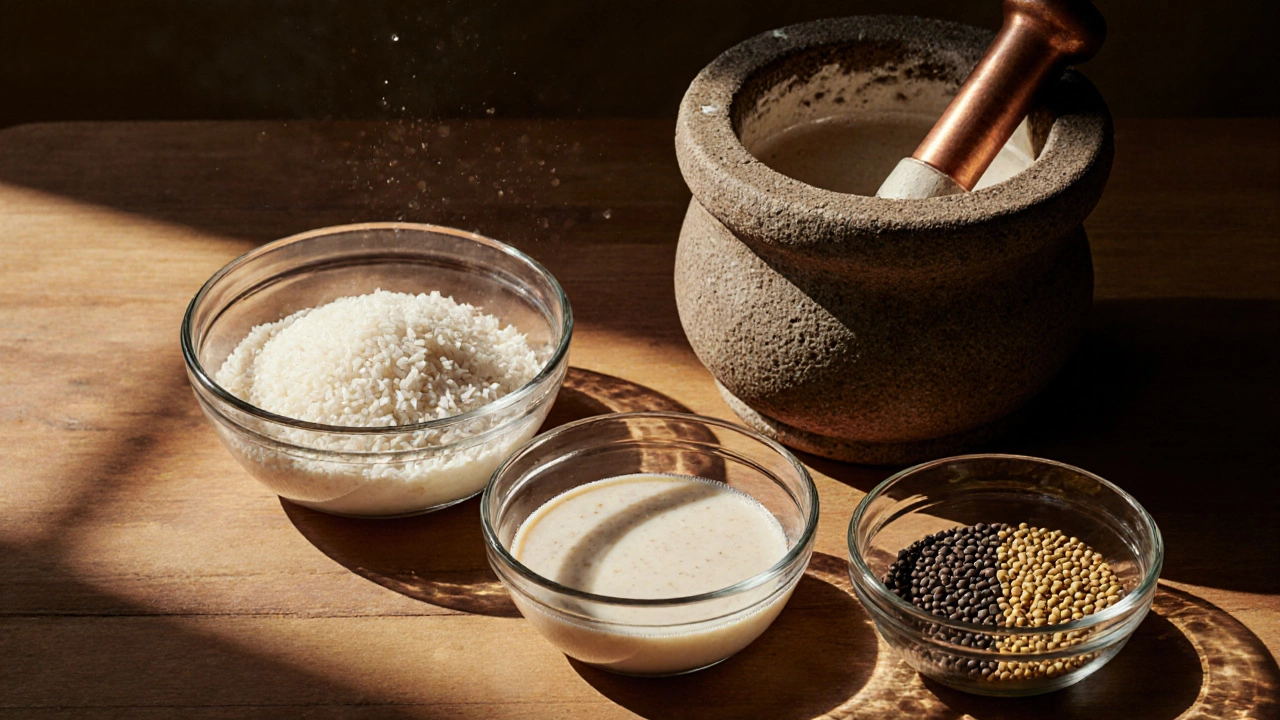Soda in Dosa Batter: The Complete Guide
When working with soda in dosa batter, the technique of mixing a pinch of baking soda into the fermented rice‑and‑lentil blend to improve rise and texture. Also known as baking soda for dosa, it can turn a flat, soggy crepe into a light, airy bite in minutes.
The base you’re tweaking is dosa batter, a mixture of soaked rice, urad dal, and water that ferments overnight to develop flavor. Many home cooks think the batter’s only job is to soak and ferment, but the moment you add soda, you introduce a chemical lift that speeds up bubble formation during cooking. This lift works best when the batter already contains urad dal, split black gram that provides protein and a natural slimy texture essential for fermentation. The dal’s mucilage captures the carbon dioxide released by the soda, creating a network of tiny pores that make each dosa crisp on the edges and soft inside.
Behind the scenes, fermentation, the natural process where wild microbes break down starches into acids and gases, sets the stage for soda to shine. A well‑fermented batter already has a mild sour note and a fluffy structure; soda simply amplifies the gas bubbles while raising the pH just enough to prevent the batter from turning too sour during cooking. The result is a dosa that lifts higher, cracks beautifully, and holds a golden crunch without sacrificing the characteristic tang.
How to Add Soda for the Best Results
Start with a batter that’s been fermenting for 8‑12 hours at room temperature. Measure out ½ teaspoon of baking soda for every cup of batter—roughly 250 ml. Dissolve the soda in a tablespoon of warm water and stir it gently into the batter just before you heat the pan. Don’t over‑mix; a light fold keeps the trapped air intact. Let the batter rest for five minutes; this short pause lets the soda react with the leftover acids, creating a burst of bubbles you’ll see when you pour the batter onto the hot surface.
In practice, soda in dosa batter works best on a well‑seasoned cast‑iron or non‑stick griddle. Heat the pan until a droplet of water sizzles, then pour a ladleful of batter and spread it thin. Within seconds you’ll notice the edges lifting faster than a plain batter. Flip only once, and you’ll get a perfectly browned underside with a soft, airy interior. If you prefer extra crispiness, let the first side cook a bit longer before flipping; the soda‑induced bubbles create a natural lattice that crisps up nicely.
Watch out for common pitfalls. Adding too much soda makes the batter taste soapy and can cause it to collapse after cooling. Also, if your batter is still too warm from fermentation, the soda’s reaction may be too aggressive, leading to large holes and uneven texture. The sweet spot is a batter that’s at room temperature, lightly bubbling, and has a slightly sour aroma.
Now that you know why soda matters, how it interacts with urad dal, and the role of fermentation, you’re ready to experiment. Below you’ll find articles that cover everything from health angles of Indian cooking to the science of soaking pulses, so you can deepen your understanding of each component. Whether you’re chasing the crispiest breakfast dosa or looking for a quick shortcut on a busy weekday, the tips here will help you get consistent, restaurant‑quality results every time.

Why Add Soda to Dosa Batter? Benefits, Ratios & Tips
Discover why a pinch of soda improves dosa batter, the right ratios, alternatives, and troubleshooting tips for perfect crispy dosas every time.
- Chutney Recipes (13)
- General (11)
- Healthy Living (10)
- Easy Indian Recipes (9)
- Chicken Curry Recipes (9)
- Healthy Indian Snacks (8)
- Paneer Recipes (7)
- Dal Recipes (7)
- Street Food (7)
- Dosa Recipes (7)
-
Best Way to Eat Chutney: Easy Tips and Tasty Pairings
7 May 2025 -
The #1 Superfood: Surprising Health Benefits, Uses, and Science-Backed Facts
18 Jul 2025 -
India’s Official Sweet: Stories, Flavors, and Cultural Secrets of Rasgulla
30 Jul 2025 -
What to Eat with Chutney: Delicious Pairings & Serving Ideas
5 Jul 2025 -
What Makes Chicken Curry Taste Better?
20 Mar 2025
17.10.25
Kaia Binari
0